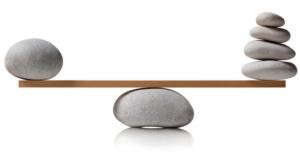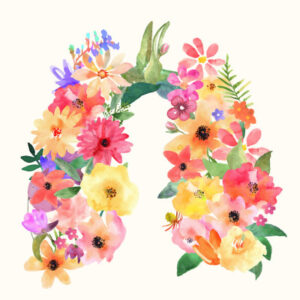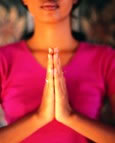By Mark Halpern
Have you ever wondered why some yoga poses seem to leave you calm, centered, and balanced, while others make you agitated, sore, and off center? Or why your best friend flourishes in a rousing “Power Yoga” workout, while you do best on a regimen of slow, gentle, stretching?
The ancient Indian healing system known as Ayurveda can help you answer such questions. According to Ayurveda, different people require very different yoga practices. As a yoga teacher and doctor practicing Ayurvedic medicine, I’ve experienced firsthand how Ayurveda—in addition to the dietary and lifestyle advice that it is best known for—can shed light on the practice of yoga.
Sisters
Yoga and Ayurveda are two paths intertwined in such a close relationship that it is hard to imagine traveling down one of these paths without knowledge of the other. Ayurveda, which means “knowledge of life,” is the ancient art and science of keeping the body and mind balanced and healthy. Yoga is the ancient art and science of preparing the body and mind for the eventual liberation and enlightenment of the soul.
Like hatha yoga, Ayurveda teaches how to keep the physical body healthy, and how this health relates to our spiritual journey. Both yoga and Ayurveda spring from the ancient Sanskrit texts called the Vedas. According to Vedic scholar David Frawley, "Yoga is the practical side of the Vedic teachings, while Ayurveda is the healing side." In practice, both paths overlap.
In fact, Ayurveda and yoga are so closely related that some people argue that Patanjali, the first codifier of yoga, and Caraka, the first codifier of Ayurveda, may have in fact been one and the same person. Philosophically, both yoga and Ayurveda are rooted in Samkhya, one of six schools of classical Indian thought. The foundation of this philosophy can be described as follows:
- There exists a fundamental state of pure being that is beyond intellectual understanding and which all life consciously strives for. This is the state of enlightenment or self-liberation.
- Suffering is a part of our lives because of our attachment to our ego or self-identity (ahamkara).
- The path toward ending suffering is the path of dissolving or transcending the ego. In doing so, all fear, anger, and attachment are eradicated.
- To achieve this goal, we must live a purely ethical life. (Ethical guidelines are listed as the yamas and niyamas in the Yoga Sutra of Patanjali.)
- Any disturbance within the mind or body interferes with this path. Ayurveda is the science of keeping the biological forces in balance so that the mind and body may be healthy.
Fundamentals of Ayurveda
According to Ayurveda, the universal life force manifests as three different energies, or doshas, known as vata, pitta, and kapha. We are all made up of a unique combination of these three forces. This unique combination, determined at the moment of conception, is our constitution, or prakruti. The three doshas constantly fluctuate according to our environment, which includes our diet, the seasons, the climate, our age, and many more factors. The current state of these three doshas most commonly defines our imbalance, or vikruti. Since we all have a unique constitution and unique imbalances, each person’s path toward health will be unique. In addition, what will keep each of us healthy is also unique. Understanding our prakruti and vikruti offers each of us the potential to make correct choices.
The three doshas are generally described in terms of the five elements: earth, air, fire, water, and ether (the subtle energy that connects all things). Vata is said to be made up of air and ether. Likened to the wind, it is said to be light, drying, cooling, and capable of movement. Pitta is said to be made up of fire and water. Considered to be mostly fire, it is hot, light, and neither too dry nor too moist; it does not move on its own, but it can be easily moved by the wind (vata). Kapha is said to be made up of water and earth, which combine like mud. Kapha is heavy, moist, cool, and stable.
The three doshas fluctuate constantly. As they move out of balance, they affect particular areas of our bodies in characteristic ways. When vata is out of balance—typically in excess—we are prone to diseases of the large intestines, like constipation and gas, along with diseases of the nervous system, immune system, and joints. When pitta is in excess, we are prone to diseases of the small intestines, like diarrhea, along with diseases of the liver, spleen, thyroid, blood, skin, and eyes. When kapha is in excess, we are prone to diseases of the stomach and lungs, most notably mucous conditions, along with diseases of water metabolism, such as swelling.
When working with the doshas, remember these basic principles: Like increases like, and opposites balance each other. In other words, foods, weather, and situations that have similar characteristics as the doshas will increase them; those that have opposite characteristics will decrease them. Knowing this, you can adjust your yoga practice, diet, and other environmental factors to affect these forces in ways that create greater balance and harmony. (For example, vata types—who are dry, light, and airy—should avoid foods with similar qualities, like popcorn, and consume foods with opposite qualities, like warm milk).
The Three Gunas
Another fundamental Ayurvedic principle is the idea of the three gunas, or qualities of nature. The three gunas—sattva, rajas, and tamas—are used to describe emotional and spiritual characteristics.
That which is sattvic is light, clear, and stable. Sattva is the state of being which comes from purity of mind, and leads to an awareness of our connectedness to God, a state in which we manifest our most virtuous qualities.
That which is rajasic is active, agitated, or turbulent. Rajas arises when we are distracted from our truest essence, and manifests emotions such as fear, worry, anger, jealously, attachment, and depression.
That which is tamasic is heavy, dull, dark, and inert. Tamasic actions include violent or vindictive behavior, along with self-destructive behaviors such as addiction, depression, and suicide.
All movement or activity is by nature rajasic (agitating) and heating to the body. Yet some movements are more agitating and others less so. Generally speaking, the slower the movement, the less rajasic and the less agitating to the body and mind. The faster the movement, the more rajasic and the more heating it will be.
Any movement practiced with great awareness becomes more sattvic. Movements done with distraction or less attentiveness are more rajasic. Thus, one way to enhance our experience of yoga is to practice slowly and with awareness.
No movement can be purely sattvic. The inherent nature of movement is rajasic, as rajas is the principal of energy, and movement requires energy. Hence our sattvic qualities are most nurtured in meditation and in the stillness of holding a pose, where we can find pure awareness.
The rajasic nature of movement does not necessarily make it bad for us. Rajas serves the useful purpose of stimulating our bodies and minds. We could not function in our world without a part of us being rajasic.
What Sort of Yoga is Right for You?
When determining the kind of yoga practice that is right for you, the most important factor is your vikruti, or imbalance. Your vikruti is, in fact, the single most important determinant of your entire regime. Once you have corrected your imbalance, you can stay in good health by choosing a yoga practice that balances your constitution, or prakruti. (It’s sometimes hard for the lay person to distinguish between characteristics that are inborn, or constitutional, and those that result from an imbalance. For best results, consult a trained Ayurvedic physician.)
This article is an excerpt from Yoga Journal .. www.yogajournal.com
 We all have poses that we feel strong in and poses that we experience a feeling of flexibility. But how often are you aware of the subtle “tug-of-war” that goes on within each pose between power and release?
We all have poses that we feel strong in and poses that we experience a feeling of flexibility. But how often are you aware of the subtle “tug-of-war” that goes on within each pose between power and release? We all have poses that we feel strong in and poses that we experience a feeling of flexibility. But how often are you aware of the subtle “tug-of-war” that goes on within each pose between power and release?
We all have poses that we feel strong in and poses that we experience a feeling of flexibility. But how often are you aware of the subtle “tug-of-war” that goes on within each pose between power and release?



 Older participants not only gained better memory but their brains worked better
Older participants not only gained better memory but their brains worked better